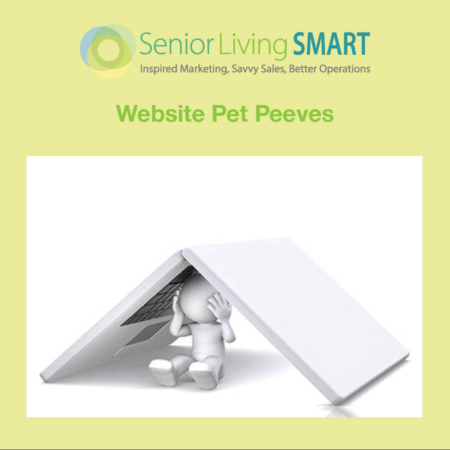Marketing During a Pandemic: How to Adjust Your Community’s Messaging
[Editor’s note: The following content was inspired by discussions during our senior living marketing webinar about the pandemic, which you can access for free here.]
Due to COVID-19 and the 24/7 news cycle, all eyes are on senior living communities, for better or worse.
In a recent article, we talked about how your community can use Facebook Live to help combat negative perceptions. Now, let’s have a deeper conversation about marketing during a pandemic.
In particular, let’s discuss how the senior living marketing team should re-frame your messaging during these unprecedented times.
1. Go longer and deeper with your messaging when marketing during a pandemic.
When it comes to effective content marketing for senior living communities, we usually advocate succinct, punchy copy. Right now, however, most people are stuck at home (whether they’re working or not), so you’re going to have a captive audience like never before. This means you can go longer and more in depth because people 1) are craving detailed info and 2) they have the time to read, watch, listen.
So what do we mean by going deeper? Don’t forget, you live and breathe the senior living industry every day, so everything is second nature to you, right? But for those on the outside looking in, they don’t know all the details. And thanks to the current media spotlight, people are curious. So educate them. Get into the fine details, the inner workings, the “inside baseball” stories, as we like to say.
Inside baseball is a metaphor for the minutiae—the detailed inner workings of a system that are usually only interesting to insiders and aficionados. Right now, many people are interested in the inner workings of senior living communities, such as how cleaning/disinfecting is done and who determines the daily menus.
Your content could be a series of “How We Do X” blog posts:
- How We Clean During a Pandemic
- How We Handle Social Distancing in Our Community
- What Goes Into Creating a Daily Menu
- How We Source Local Ingredients
You get the idea.
2. Talk about those “boring” topics you never would normally discuss in senior living marketing materials.
For example, who ever thought a topic like “senior living community supply chains” would be a must-read topic, yet here we are!
Right now, everybody’s focused on their own personal supply chain management. If you can show the differences between institutional supply chain management and your personal household management around toilet paper, eggs, and sanitizer, that will be a GREAT service to people.
How to accomplish this? Well, do something educational and reassuring by taking people “behind the scenes” via a Facebook Live video and bring them into the kitchen and supply closets and show an abundance of food and supplies like toilet paper—it’s not a direct sales message, but it certainly is a comforting one. People can “see” for themselves and think, “Mom will be OK. They have supplies, they have folks who are cleaning, and they have the infrastructure already built right in.”
No, this isn’t something that you would ever put in a marketing brochure—”Hey, when you choose our senior living community, you’ll always have toilet paper!” But right now, this is something that’s top of mind for people.
Bottom line: there are some interesting opportunities for creative storytelling around things that you never thought you would tell a story about.
3. Show your community’s commitment to—and expertise with—supporting older adults.
One example would be instead of simply saying you provide a safe environment, walk people through the exact procedures and protocols that you put in place to ensure safety every day.
And not just from a health perspective—yes, that’s the main concern on everyone’s mind right now, thanks to COVID-19—but also physical safety. For instance, how many lay people understand what the term “elopement” means when it comes to older adults? This is a great opportunity to educate about an industry-specific topic and to demonstrate your community’s specific approach.
4. Share the spotlight.
Again, this is a great opportunity to take people deep inside your daily operations. People love to understand how things work, so take advantage of that. You have talented people working in your communities. Make them the stars of these stories.
For example, bring forward your dining room supervisor, your chef, the person who’s running activities, or your head of healthcare. Make them the focus of your content and let them talk about what it is that goes into delivering the kinds of services that make up your community.
Hint: these make great topics for Facebook Live events (and then you can repurpose the content into blog posts and other written content).
5. Show your city/town spirit.
So many people are hunkering down right now and taking a keen interest in their local communities, particularly small businesses. Demonstrate how your senior living community supports and celebrates the businesses in your local town/city.
For example, talk about local businesses that you buy from/rely on. Keep a section of your COVID-19 website page dedicated to information that older adults (and their families) would find helpful, such as grocery store hours for older adults, pharmacy drive-thrus/deliveries, restaurants still offering takeout, and so forth.
Again, you’re celebrating your local town and city while also making your senior living community website a destination for responsible and accurate information as it pertains to seniors.
6. Continue to create responsible COVID-19 resources.
No one wants to be creating this content, but here’s the thing: YOU are uniquely positioned to discuss COVID-19 from a senior living perspective because YOU WORK IN THE INDUSTRY. Don’t let the uninformed or misinformed take control of your community’s story or narrative.
Instead, continue to create responsible COVID-19 resources that will truly help your residents, their families, prospects, staff, and the media.
Some ideas:
- X Underreported Things Everyone Over 60 Should Know About COVID-19
- Step-by-Step Guide to Skype and Facetime
- X Ways to Keep in Touch with Your Senior Loved Ones During Lockdowns
- Keep the Body Moving: X Great Alternatives to Daily Group Walks
- X SMART Strategies for Helping Seniors Stay Safe during a Pandemic
Need more topics? People are searching on topics in Google all the time. Conduct a search on your own, such as “keeping seniors safe during COVID,” and scroll to the bottom for “People Also Search On” for additional ideas.
7. Share positive stories and messages, too.
People are rightly concerned about this pandemic, but that doesn’t mean you should forget to share happy news. Perhaps it’s a picture of a resident celebrating a birthday with their family members looking on through the window. Or it could be something as simple as sharing a pic of daffodils blooming in front of your building or outside a resident’s window.
8. Reconsider print advertising and direct mail.
With so many people stuck at home, now might be a great time to run some local newspaper ads and/or do some direct mail campaigns. You don’t need to “sell” either—it could simply be an alert regarding some strategies about how you’re keeping seniors in your communities safe. The call to action could be to set up a virtual tour or to join the next Facebook Live event. Psst: we make designing print pieces extremely turnkey—check out SMARTbrand.
Need help marketing during a pandemic?
We’re always happy to help senior living communities with their marketing during a pandemic or other crisis. Don’t hesitate to get in touch. And be sure to check out our COVID-19 resource library—everything is free to download.






